With over 3.5 million sport injuries estimated to occur each year (Johns Hopkins Medicine, 2023), we spent the last several weeks digging into and describing injury patterns related to specific sports: basketball, soccer, baseball/softball, and football. Although we’ve seen interesting trends in similarities of injuries across injury locations in basketball and high rates of face and head injuries for kids within the baseball or softball injuries, we still had questions about the people in our data set who had multiple injuries – were they related to the same sports, or are they getting injured across different sports?
For collegiate athletes, over 20% of injuries require more than a week of recovery time before the individual is able to return to full participation (Kerr et al., 2015). The goal of many players, coaches, families, etc. is to safely continue participation after an injury. When an athlete experience multiple injury events, there can be an extended recovery period. Anecdotally, our team has seen or experienced injuries that were captured by these inclusion criteria, so we were curious to learn if our experiences were anomalies, or if the injury patterns we experienced were common?
What we found correlated to our expectations: we saw the majority of repeat injuries occurred within the same sport. Among those with multiple injuries from the same sport, we saw higher rates of repeat injuries on the same body part, whereas people who were injured multiple times but from different sports saw different body parts affected and also generally had more time between injuries.
Methods
We defined sports-related injury encounters using a subset of ICD-10 codes associated with 5 sports: baseball, basketball, football, soccer, and softball. For the purposes of this report, baseball and softball were grouped together. Using a subset of Truveta Data, we identified over 10,500 people who had two or more injuries that involved a hospital visit.
We compared the age, sex, and time between injuries for each type of injury combination. We also looked at the location of the encounter to understand how people engaged with the healthcare system when injuries occurred.
Finally, we classified the body parts that were injured in each initial injury and subsequent injury and compared to see if they were the same. We used diagnostic codes that were associated with the same encounter as the injury and classified them into 13 categories according to injury location (cardiac/chest, concussion/TBI, face/head, groin, lower extremity, neck/back, pain in unspecified location, trunk, upper extremity, other location, unrelated to place of injury on the body). For this analysis we excluded diagnoses that were classified as ‘other location’ or ‘unrelated to place of injury on the body.’ We also excluded a small set of injuries that were associated with multiple sports (i.e., one injury was linked to both basketball and soccer).
Results
We found that the majority of people with multiple injuries had two injuries; only 23% of people who have multiple sport-related injuries have more than two.
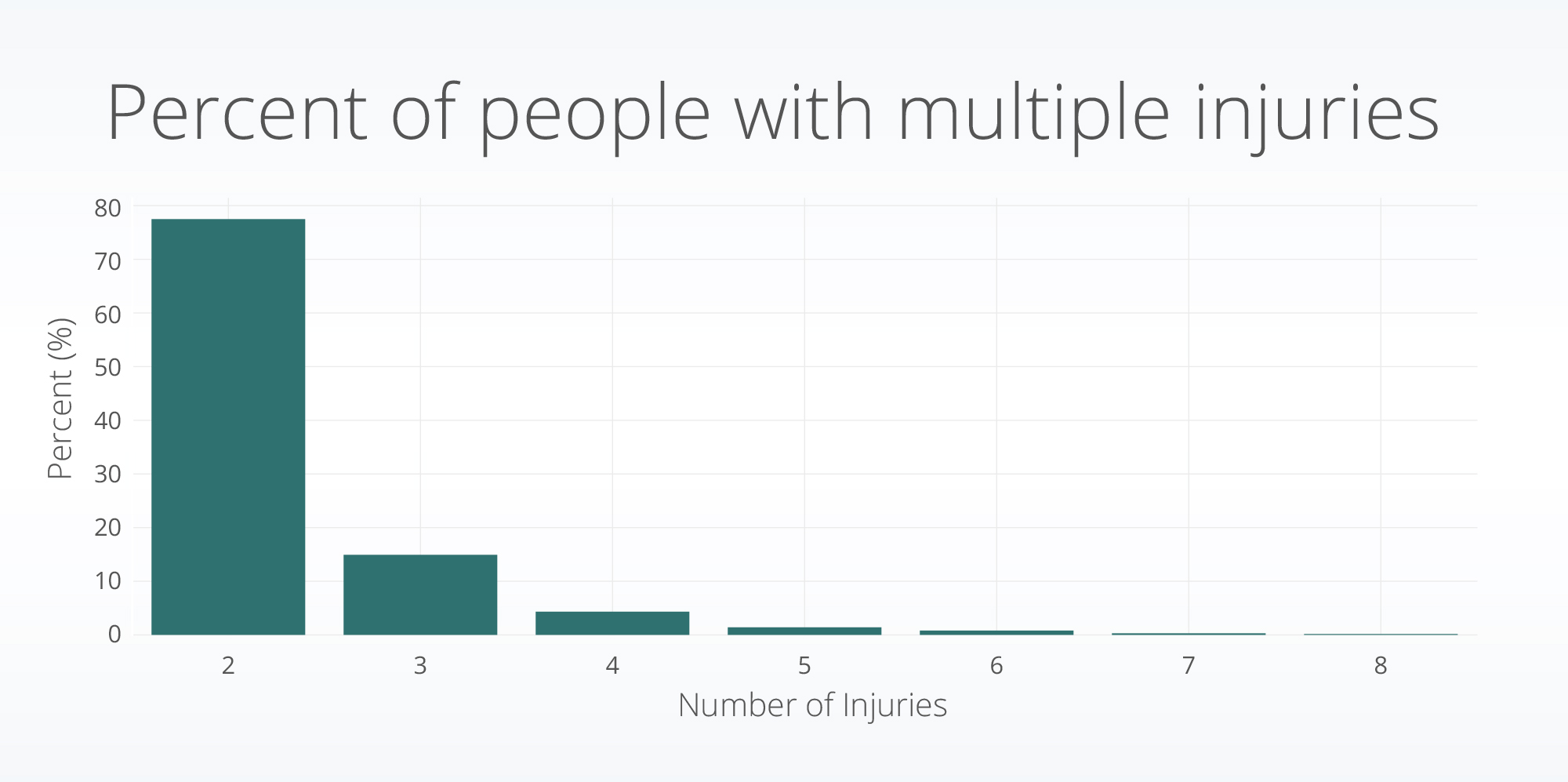
We found 75% of people with multiple injuries occurred within the same sport. Interestingly, a higher percentage of people had the combination of basketball and football compared to two baseball or softball injuries. All other multi-sport injury combinations were lower than the single sport injury combinations.
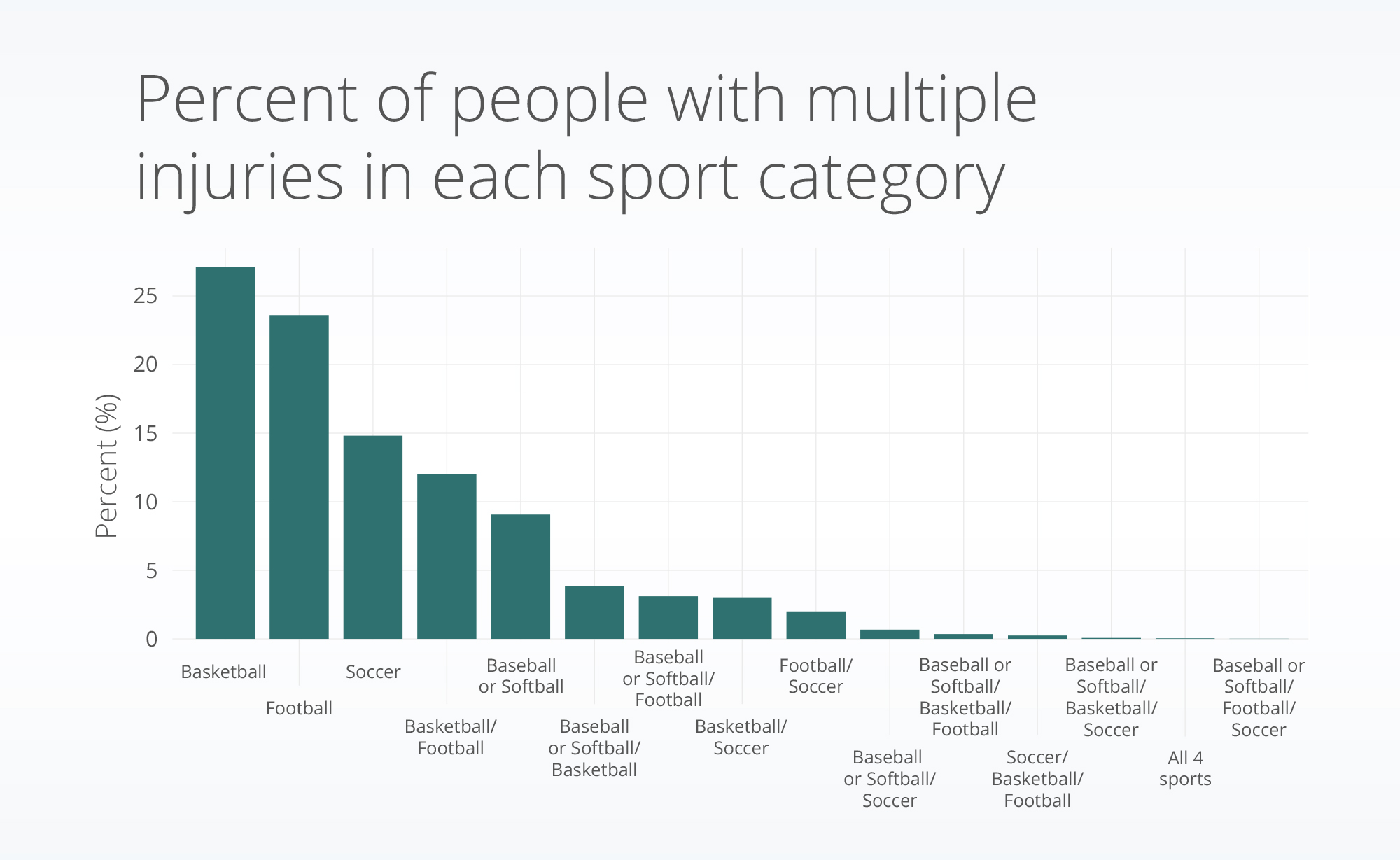
We see differences by sex and age group in the percentage who had multiple injuries. For example, nearly 30% of females with multiple injuries were repeat injuries playing soccer; whereas only 12% of males with multiple injuries had repeat injuries playing soccer. Instead, males had higher rates of repeat football injuries. Other high-rate injury combinations included repeat baseball or softball injuries for females and basketball and football for males.
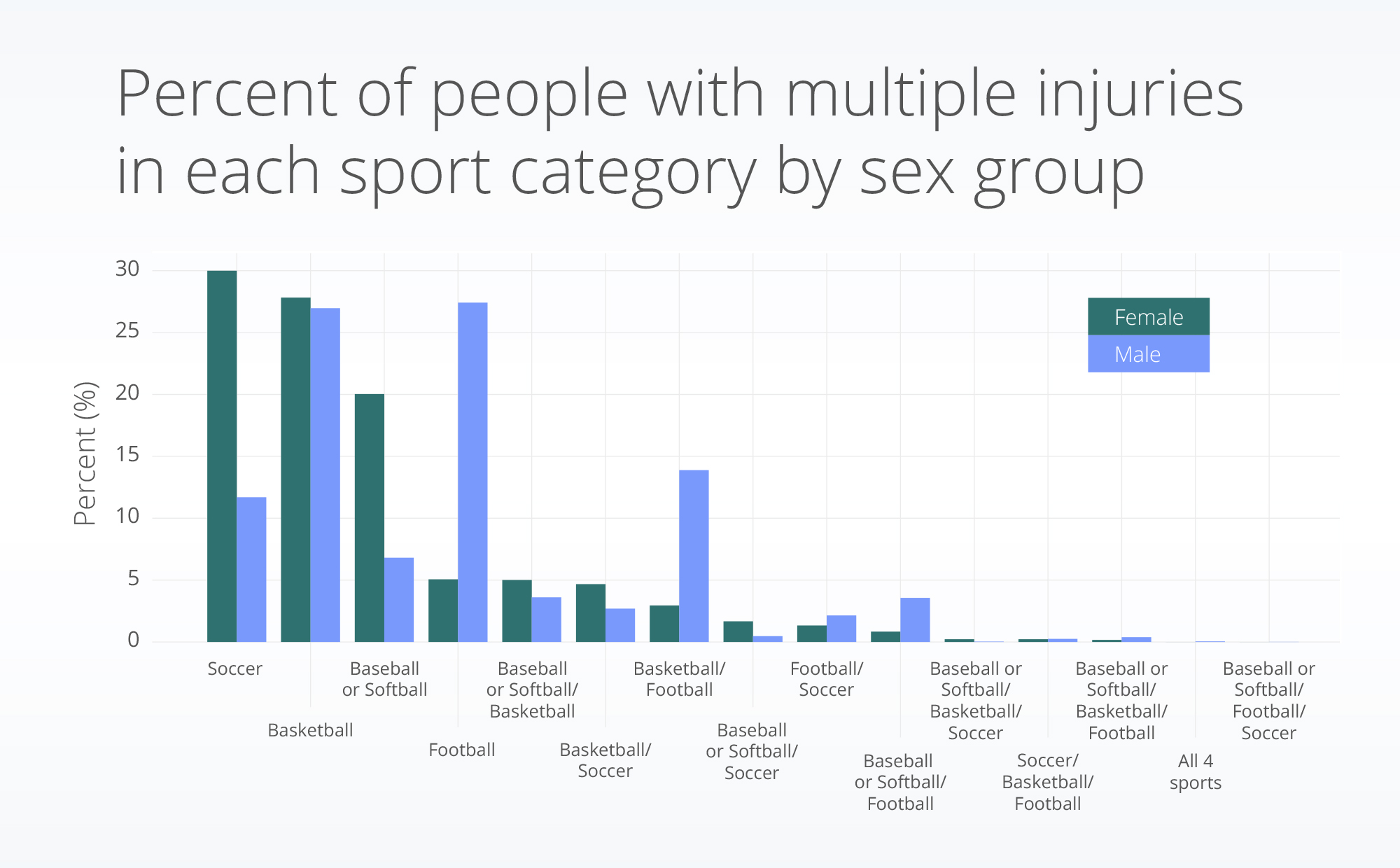
We excluded the youngest (individuals under 5) and oldest (individuals over 65) from this analysis due to the small sample size. For the oldest age group included here (those aged 45–64), we see the highest rate of multiple injuries occur for repeat baseball or softball (33%) and repeat basketball (31%) injuries. We see higher percentages of combination-sport (i.e., baseball of softball and football) injuries amongst younger individuals (those in the 5-9, 10-13, and 14-17 age groups) than older age groups (age groups aged 18 and over). Amongst the age groups under 18, the combination of basketball and football had the highest percentage of multi-sport injuries.
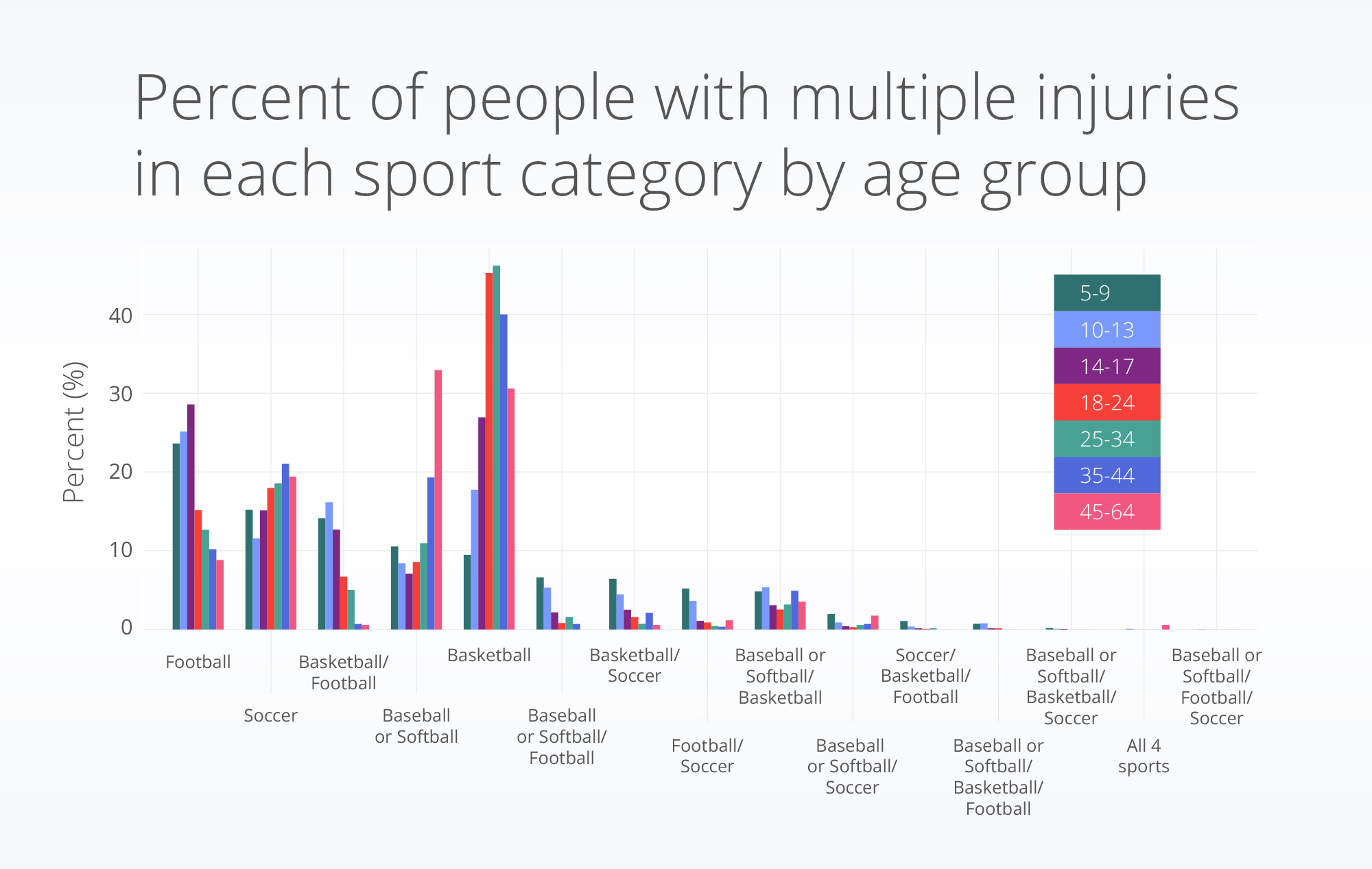
Time between injuries
For the population with only two injuries, we compared the time between injuries. 60% of all injuries that occurred within the same sport had repeat injuries within the first year. This varies from injury combinations from different sports where roughly 40% occurred within the same year, although variation by sport combination exists. For multi-sport injury combinations, we see roughly 20% of injuries occur three or more years apart, with the greatest at 21.8% for football and soccer injury combinations. This percentage is much less for injuries within one sport; for example, only 7% of repeat baseball or softball injuries occur three or more years apart.
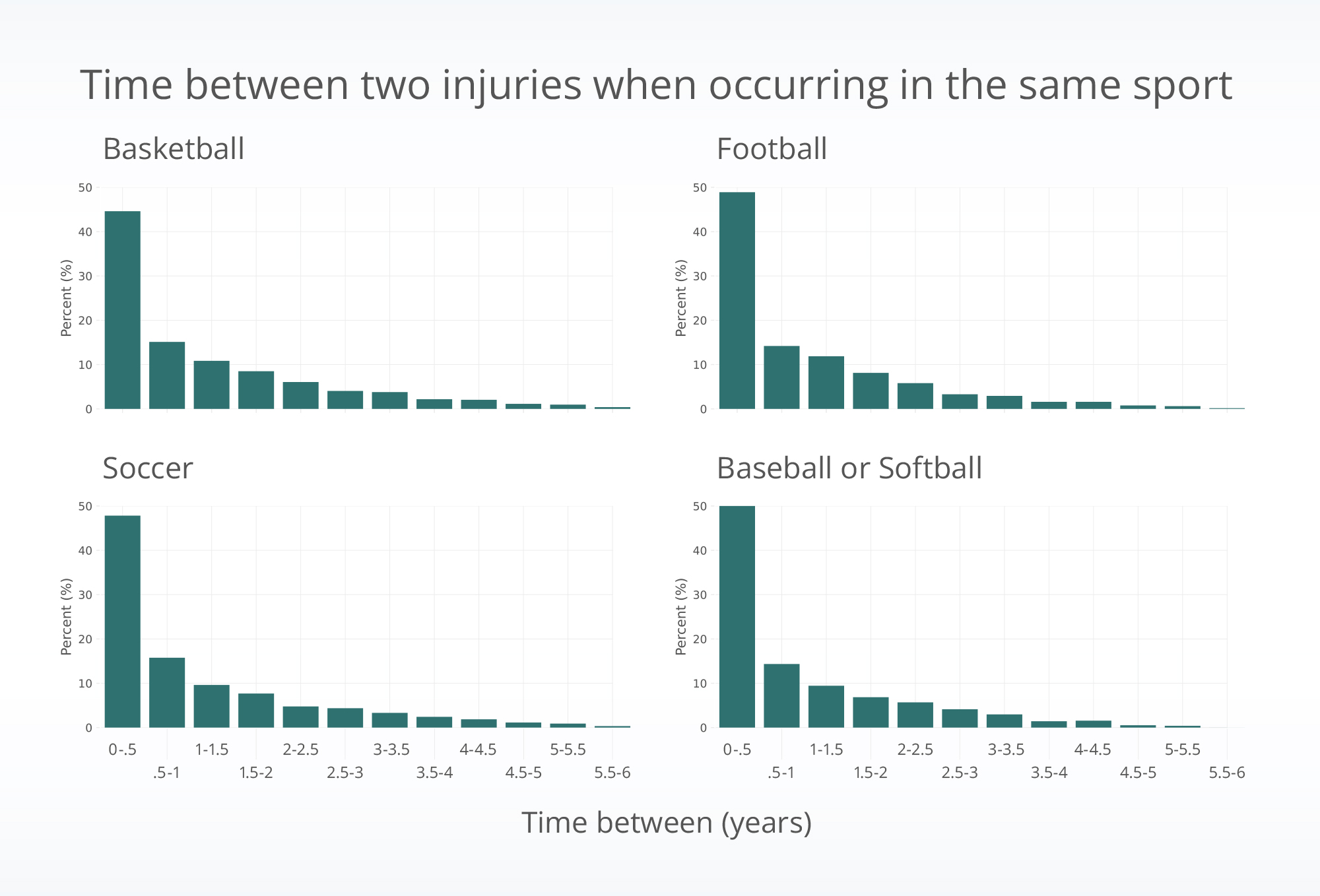
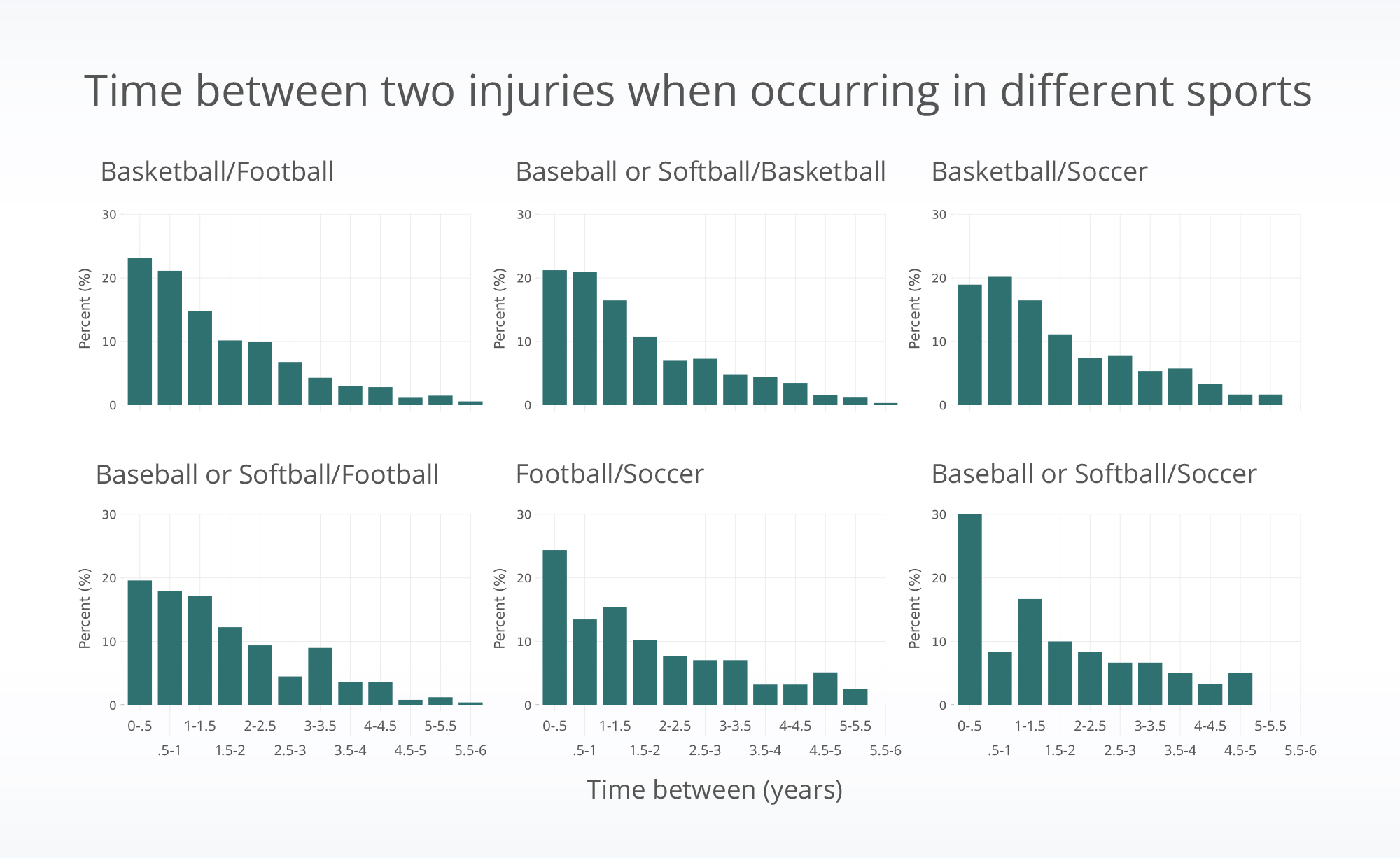
Difference in the body location affected
More than 40% of people with lower or upper extremity injuries that occurred within the same sport had repeat injuries at that same body site (aside from upper extremity soccer injuries). This means athletes may be re-injuring the same body part while playing the same sport. We saw the highest rate of lower extremity repeat injuries for soccer (56% of the population with multiple soccer injuries and at least one lower extremity injury had a repeat injury), basketball (54%), and baseball or softball (46%). The highest rates of upper extremity re-injuries occurred within football (51%) and baseball or softball (49%).
We saw lower rates of repeat injuries for athletes with multiple injuries across different sports. For example, 37% of the population with soccer and basketball injuries and at least one lower extremity injury had repeat lower extremity injuries, even though those were the two sports with the highest repeat lower extremity injuries.
Repeat concussions were highest amongst populations with multiple soccer or football injuries. More than 9% of people with multiple soccer or football injuries experienced more than one concussion. This is important because subsequent concussions can lead to longer recovery times and long-term problems (Control et al., 2015).
It’s important to note that more than one body location could be affected in each injury (i.e., a person could have an injury in which both the upper extremity and face/head were affected).
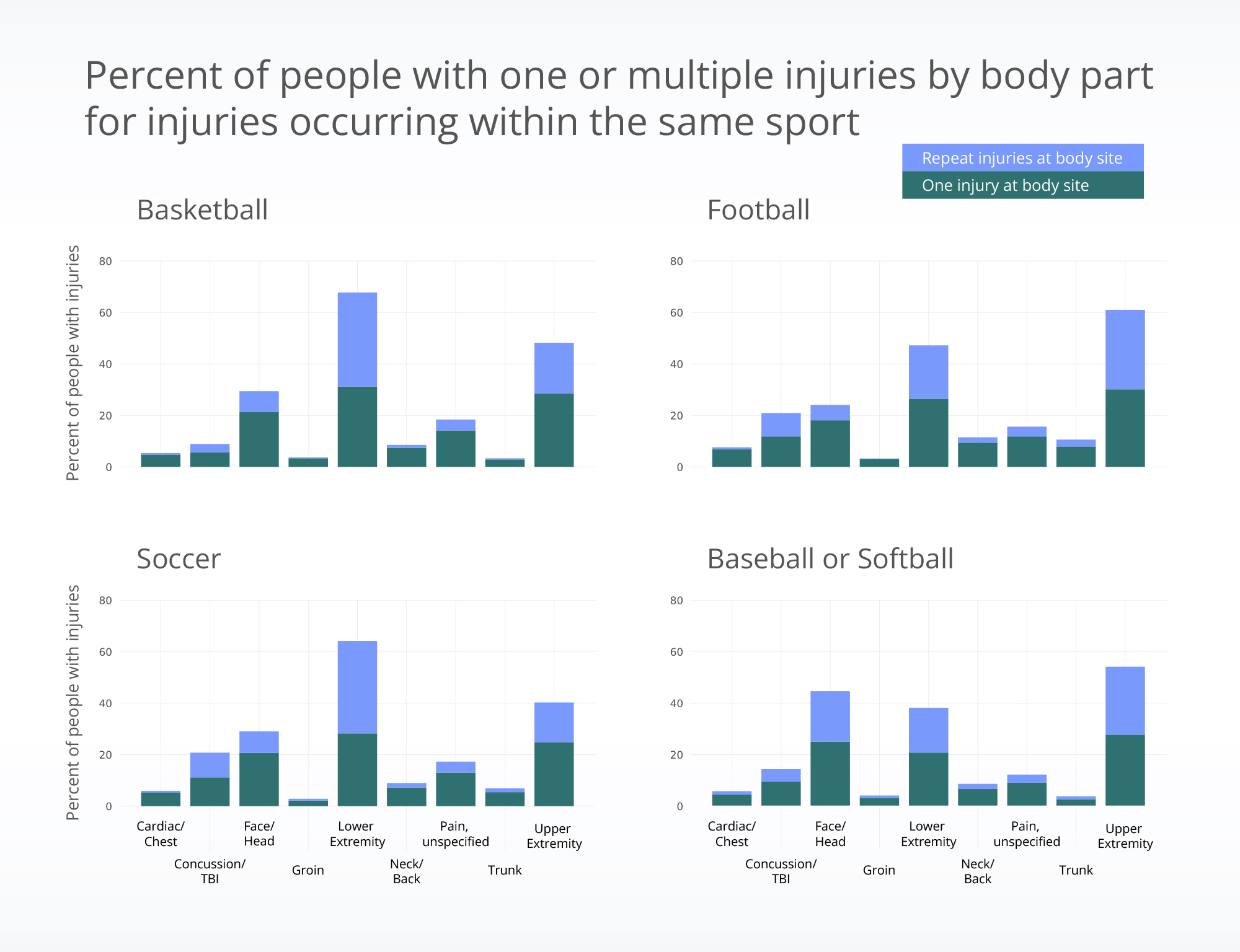
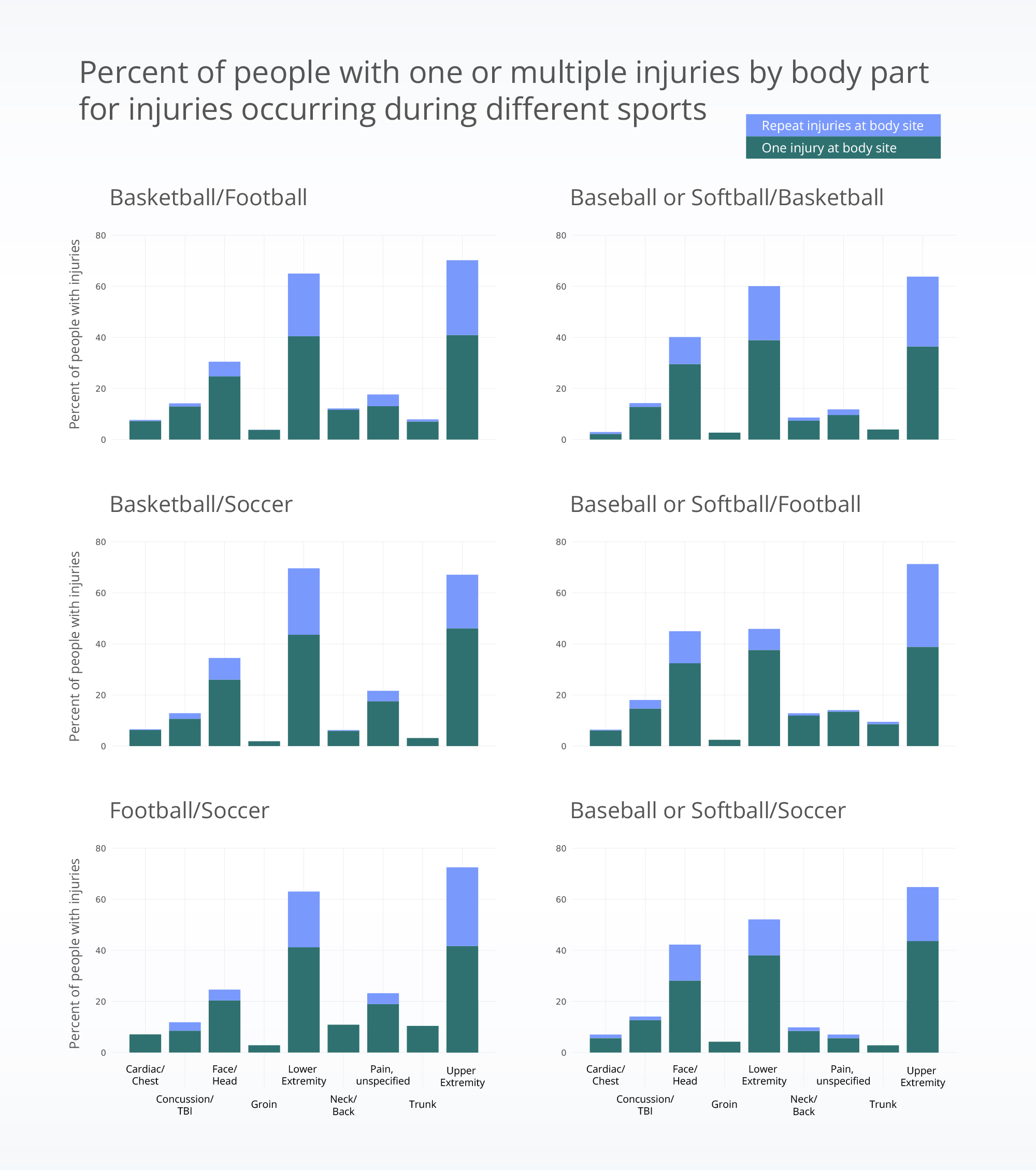
Discussion
With nearly 3 million emergency department visits caused by sports-related injuries in children each year (Rui et al., 2019), sports injuries are an important area of study. Although data sets and research exist aimed at understanding who has different types of sport injuries, little research exists looking at people with multiple or repeat injuries. Research that have investigated repeat injuries often study a subset of injuries and sports (Manara et al., 2022; Wright et al., 2020).
We found a smaller percentage (~11%) of people with injuries requiring a hospital visit had repeat injuries, and the majority of these people only had two events. Most of the repeat injuries occurred within the same sport, with the exception of basketball and football injuries, which had a higher percentage of injuries than two baseball or softball injuries.
The male population who had multiple injuries was primarily comprised of basketball, football, and basketball and football injury combinations. The population of females with multiple injuries were mostly comprised of soccer, basketball, and baseball or softball repeat injuries. This difference in injury patterns is likely due in part to which sports each sex are playing (The National Federation of State High School Association, 2022). Further, the difference in age distributions across single sports or different sport combinations may be due to the fact that individuals under 18 are more likely to play more than one sport.
When injuries occurred across different sports there was, on average, more time between the injuries than when the injuries happened during the same sport. This may be due to decreased healing time during a specific sport’s season, where additional time is inherently given when injuries occur across multiple sports, due to sports taking place in different seasons.
We found a high number of repeat injuries of the upper and lower extremities for all injuries within the same sport. This was not the case with multiple injuries spanning multiple sports, which may indicate differences in how the body is used in each sport. Repeat concussions or TBI were highest in multiple soccer and multiple football injuries.
There are a few limitations in this analysis. First, we did not consider the sequence of multiple injuries if they occurred in more than one sport. For example, a basketball injury with a football injury six months later would be considered the same as a football injury with a basketball injury six months after. We also only presented combinations of two sports when looking at the time between events and the percent of injuries by body parts. Although there were people with more than two sport injuries, the majority of the available data in this study fits into this category. The age analysis was based on the age at first injury, so some people may have aged into a different age group during the subsequent injuries.
These are preliminary research findings and not peer reviewed. Data are constantly changing and updating. These findings are consistent with data pulled January 11, 2023.
References
Control, C. for D., Prevention, & others. (2015). Report to congress on traumatic brain injury in the United States: Epidemiology and rehabilitation. National Center for Injury Prevention and Control, 2, 1–72.
Johns Hopkins Medicine. (2023). Sports Injury Statistics. Health. https://www.hopkinsmedicine.org/health/conditions-and-diseases/sports-injuries/sports-injury-statistics
Kerr, Z. Y., Marshall, S. W., Dompier, T. P., Corlette, J., Klossner, D. A., & Gilchrist, J. (2015). College sports–related injuries—United States, 2009–10 through 2013–14 academic years. Morbidity and Mortality Weekly Report, 64(48), 1330–1336.
Manara, J. R., Salmon, L. J., Kilani, F. M., Zelaya de Camino, G., Monk, C., Sundaraj, K., Pinczewski, L. A., & Roe, J. P. (2022). Repeat Anterior Cruciate Ligament Injury and Return to Sport in Australian Soccer Players After Anterior Cruciate Ligament Reconstruction With Hamstring Tendon Autograft. The American Journal of Sports Medicine, 50(13), 3533–3543. https://doi.org/10.1177/03635465221125467
Rui, P., Ashman, J. J., & Akinseye, A. (2019, November 15). Emergency Department Visits for Injuries Sustained During Sports and Recreational Activities by Patients Aged 5–24 Years, 2010–2016. National Health Statistics Reports; Centers for Disease Control and Prevention. https://www.cdc.gov/nchs/data/nhsr/nhsr133-508.pdf
The National Federation of State High School Association. (2022). High School Athletics Participation Survey. https://www.nfhs.org/media/5989280/2021-22_participation_survey.pdf
Wright, M. J., Monti, M. M., Lutkenhoff, E. S., Hardy, D. J., Litvin, P. Y., Kelly, D. F., Guskiewicz, K., Cantu, R. C., Vespa, P. M., Hovda, D. A., Lopez, W. D., Wang, C., Swerdloff, R., & Fuster, J. M. (2020). Memory in repeat sports-related concussive injury and single-impact traumatic brain injury. Brain Injury, 34(12), 1666–1673. https://doi.org/10.1080/02699052.2020.1825806
